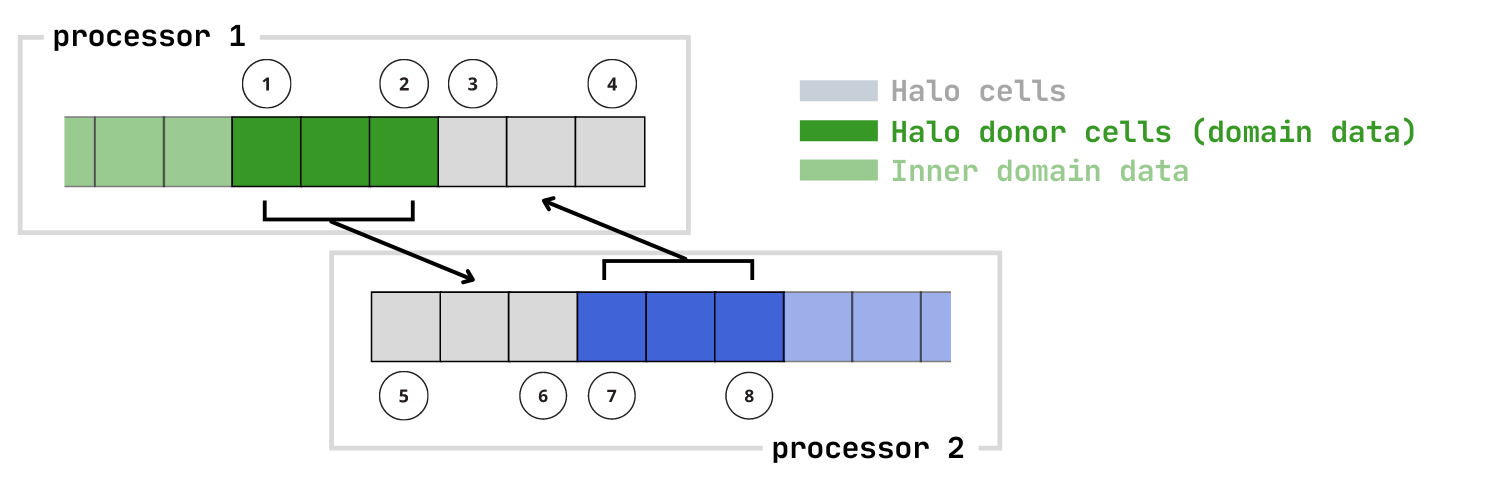MPIHaloArrays provides a high-level array type to facilitate halo, or ghost-cell exchanges commonly found in large-scale PDE codes. The MPIHaloArray type is a subtype of AbstractArray.
Inspiration was taken from MPIArrays.jl and ImplicitGlobalGrid.jl. Domains can be decomposed into 1, 2, or 3D parallel topologies.
The package can be installed with
pkg> add MPIHaloArrays- [STABLE] — most recently tagged version of the documentation.
- [DEV] — most recent development version of the documentation.
Halo exchange is a common practice in large-scale PDE codes that decompose the domain into many sub-domains. Neighbor information is exchanged at regular intervals through "ghost" or "halo" cell regions. The image below shows an example from a 1D array that has a halo region of 3 cells.
Halo exchanges can be done in multiple dimensions. At the moment, MPIHaloArrays.jl limits this to 1-3D arrays, but this will be extended in the future. The example below shows how to set up the initial array, fill halo/domain cells, do a halo exchange, and more.
Currently arrays are limited to 1, 2, or 3D. This will be addressed in future versions
using MPI, MPIHaloArrays
MPI.Init()
const comm = MPI.COMM_WORLD
const rank = MPI.Comm_rank(comm)
const nprocs = MPI.Comm_size(comm)
const root = 0
# Create the MPI topology
topo = CartesianTopology(comm, [4,4], # use a 4x4 decomposition
[true, true]) # periodic in both dimensions
nhalo = 2 # Number of halo cells in each dimension (fixed for all dimensions)
N = 200
# create the array type; this pads the data on all sides with halo regions
x = MPIHaloArray(rand(N,N), topo, nhalo)
# fill all the halo regions with -1
fillhalo!(A, -1)
# fill the domain region with the current rank
filldomain!(A, rank)
# local (current rank) indexing works just like a normal array
A[1,1] .= 2.0
# Get the local/global indices of the _domain_ data (not including the halo cells)
ilo, ihi, jlo, jhi = local_domain_indices(x) # -> useful for looping without going into halo regions
# Exchange data with neighbors
updatehalo!(x)
GC.gc()
MPI.Finalize()Scatter and gather operations are also defined with scatterglobal and gatherglobal.
root = 0 # MPI rank to scatter from / gather to
# start with a global Base.Array type to decompose and scatter to each rank
ni = 512; nj = 256
A_global = reshape(1:ni*nj, ni, nj);
# scatter - this internally converts A_global to multiple halo arrays. This is why
# the nhalo and topology types are needed
A_local = scatterglobal(A_global, root, nhalo, topology) # -> returns a MPIHaloArray
# do some work...
# and now gather the decomposed domain and store on the root rank of choice
A_global_result = gatherglobal(A_local; root=root) # -> returns a Base.ArrayIn some cases, you may want a multi-dimensional array that only does the halo exchange on a subset of the dimensions. For example, an array U, has dimensions [[ρ, u, v, p], i, j], where [i,j] represent 2D grid coordinates and [ρ, u, v, p] are the density, x/y velocity, and pressure at each [i,j] coordinate. This can be done with the following syntax:
using MPI, MPIHaloArrays
MPI.Init()
const comm = MPI.COMM_WORLD
const rank = MPI.Comm_rank(comm)
const nprocs = MPI.Comm_size(comm)
const root = 0
U = zeros(4,128,128)
# Only 1 MPI rank, but the topology is 2D
topo = CartesianTopology(comm, (1,1), (true,true))
nhalo = 2
halo_dims = (2,3)
A = MPIHaloArray(U, topo, nhalo, halo_dims)
# This will fail b/c U is 3D and the topology is only 2D; you must
# specify the halo exchange in 2D
A = MPIHaloArray(U, topo, nhalo) # -> ERROR: Mismatched topology dimensionality (2D) and halo region dimensions (3D)
Note: The default behavior selects all dimensions to exchange halo data. You must provide the halo_dims tuple to override this.
Add physical units via Unitful.jl
using MPIHaloArrays, Unitful
data = rand(10,10) * u"m"
A = MPIHaloArray(data, topology, 2)Add uncertainty via Measurements.jl
using MPIHaloArrays, Unitful, Measurements
data = (rand(10,10) .± 0.1) * u"m"
A = MPIHaloArray(data, topology, 2)A slightly more useful example that performs 2D heat diffusion is shown here. This shows how to
- Scatter initial conditions from the root node to each MPI process with
scatterglobal() - Perform a stencil operation within the current
MPIHaloArray. This looks like any other normal array loop, but the bounds are determined by theMPIHaloArrayvialocal_domain_indices() - Update halo cells / neighbor information. Periodic boundary conditions are also handled by the
CartesianTopologytype. - Gather results to the root node for plotting/output with
gatherglobal()
MPIHaloArray: An array type that extendsAbstractArrayto provide MPI neighbor communication for halo or ghost cellsAbstractParallelTopology,CartesianTopology: MPI Topology types to manage neighbor informationneighbor(), neighbors(),[i,j,k]lo_neighbor(),[i,j,k]hi_neighbor(): Extract neighbors of the current MPI ranklo_indices(),hi_indices(): Local indices of the current MPIHaloArray. Used for loop limits that ignore halo regionsfillhalo!(): Fill the halo cells with a scalar valuefilldomain!(): Fill the domain cells with a scalar valueupdatehalo!(): Perform neighbor communication / halo exchangescatterglobal(): Distribute/scatter a global array to multiple ranks - returns a localMPIHaloArrayfor each rankgatherglobal(): GatherMPIHaloArrays to a root MPI rank - returns anAbstractArrayon the root node




